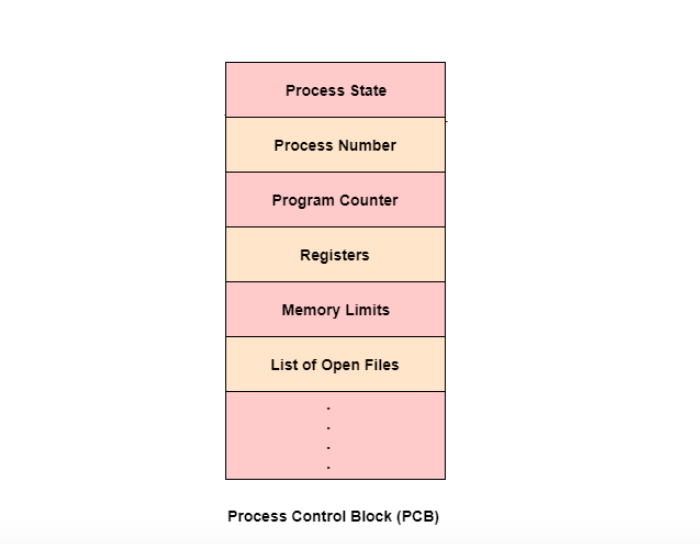Process Control Block is a data structure that contains information of the process related to it. The process control block is also known as a task control block, entry of the process table, etc.
It is very important for process management as the data structuring for processes is done in terms of the PCB. It also defines the current state of the operating system.
Structure of the Process Control Block
The process control stores many data items that are needed for efficient process management. Some of these data items are explained with the help of the given diagram −

The following are the data items −
Process State
This specifies the process state i.e. new, ready, running, waiting or terminated.
Process Number
This shows the number of the particular process.
Program Counter
This contains the address of the next instruction that needs to be executed in the process.
Registers
This specifies the registers that are used by the process. They may include accumulators, index registers, stack pointers, general-purpose registers, etc.
List of Open Files
These are the different files that are associated with the process
CPU Scheduling Information
The process priority, pointers to scheduling queues, etc. is the CPU scheduling information that is contained in the PCB. This may also include any other scheduling parameters.
Memory Management Information
The memory management information includes the page tables or the segment tables depending on the memory system used. It also contains the value of the base registers, limit registers, etc.
I/O Status Information
This information includes the list of I/O devices used by the process, the list of files, etc.
Accounting information
The time limits, account numbers, amount of CPU used, process numbers, etc. are all a part of the PCB accounting information.
Location of the Process Control Block
The process control block is kept in a memory area that is protected from normal user access. This is done because it contains important process information. Some of the operating systems place the PCB at the beginning of the kernel stack for the process as it is a safe location.
Related Questions & Answers
- What are the Process States in Operating System?
- Write about Process Control Block.
- Write Various Operating System Services.
- What is the requirement to solve the Critical Section Problem?
- Write about the Priority Inversion Problem.
- Write various multithreading models.
- Discuss preemptive scheduling.
- Consider the following set of processes........
- Write about Semaphores. Explain its properties along with drawbacks.
- Write necessary conditions for arise of Deadlock.
- Define the following Terms: Mutual Exclusion, Thrashing, Thread
- Explain the features of Time sharing system.
- What is an operating system? Give the view of OS as a resource manager.
- Explain the following UNIX Commands: (a) grep (b) chmod (c) finger (d) cat (e) sort
- What is the thread? Explain thread Structure? And explain any one type of thread in detail.
- What is PCB? Discuss its major fields.
- List the four events that cause processes to be created. Explain each in brief.
- Explain the producer-consumer problem and its solution using the monitor.
- List Deadlock recovery techniques and explain any one of them.
- Write a short note in Critical Section.
- Explain context switching.
- Differentiate between Multi-Programming and Multi-Processing System.
- Write different types of system calls?
- What is a scheduler? Explain queuing diagram representation of process scheduler.
- Define the following Terms: Throughput, Waiting Time, Turnaround Time, Response Time.
- What is deadlock? List the conditions that lead to deadlock.
- Explain Banker’s algorithm for multiple resources with examples.
- What is Semaphore? Give the implementation of Bounded Buffer.
- What is Mutex? Write pseudocode to achieve mutual exclusion using Mutex.
- Explain the IPC problem. Explain the Dining Philosopher problem.

